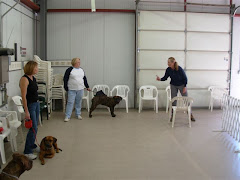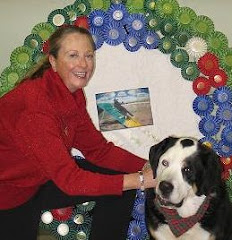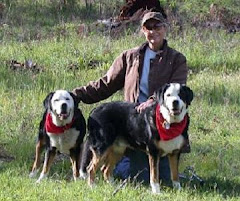
 The only two dogs who've ever sent me to ER with dog bites were both Rotties. Nonetheless, I love this breed. And their main drawback, in my mind, is NOT aggression....
The only two dogs who've ever sent me to ER with dog bites were both Rotties. Nonetheless, I love this breed. And their main drawback, in my mind, is NOT aggression....Back in the mid 1980s I didn't even know what a Rottweiler looked like. Neither did a lot of folks. Things changed quickly in the next few years, as the Rottie began to soar in popularity. With its growing status predictably came growing problems: irresponsible breeding, an increase in aggression, health concerns, and a bad reputation for being strong, uncontrollable guard dogs.
The bad rap, which was undeserved, was perpetuated by the news media, which thrives on hysteria.
Since the mid-90s, the Rottie's popularity has waned. This is actually a good thing. The breed is no longer as popular with the "wrong" type of owner (drug dealers and young men driven solely by testosterone). This means the truly responsible, serious breeders can once again restore the quality and reputation of this absolutely wonderful dog.
If you start looking for a Rottweiler, you'll hear people refer to "German" vs. "American" Rottweiler. In short, Rotties come in a variety of sizes and looks, although the true "German" Rottie is shorter and stockier, with a broader head, than the tall, huge American Rotties. The German dogs were originally bred to drive livestock, so they still actually have some droving instinct. Traveling European merchants also used them to guard their valuables; hence, the "guard dog" designation developed. Today's Rotties are used more to guard couches and small children, and they're good at driving toddlers around the yard. They have evolved into wonderful family dogs who are loyal, tolerant, and generally laid back...that is, until they need to be something else....
And then......LOOK OUT! Rotties save their strength and energy for when they really need it. When they do, they are an explosion of power and athleticism. They can move with the grace and momentum of a ballet dancer, and the tenacity of a U.S. Marine.
You're talking major MASS here. A small Rottie can weigh twice as much as a large Irish Setter. An in-shape Rottie is solid muscle. Add energy to the mass and you have awesome power.
Imagine someone throwing a fast softball into your shoulder from a distance of 50 feet. Now imagine someone throwing a solid rock at you that's the same diameter, the same speed, the same distance as the softball. That's the difference between colliding with an Old English Sheepdog and colliding with a Rottweiler. The Rottie collision is going to hurt you. That's why EARLY and ON-GOING TRAINING is absolutely necessary with anyone owning a Rottweiler. Without it, you have a potentially dangerous dog on your hands.
The Rottie is NOT aggressive by nature. But he's confident. And strong. It's easy for him to intimidate critters (including people) early-on. They usually back down to him because they can sense his strength. So he gets used to pushing his weight around, scaring off the mailman and UPS guy, and even frightening less confident members of his own household.
Given proper leadership from the get-go, however, the Rottie can be the mellowest of family members. They make excellent therapy dogs, they love to please, and they do well in dog sports like obedience competition. They're not popular in agility competition because they're so heavy and massive that the activity and heat is hard on them. They don't have much endurance, since they use their strength in spurts. But they enjoy some form of work and thrive on it. If you have a Rottie, find employment for her--pulling a wagon, accompanying you to nursing homes, or visiting schools to give dog safety talks to young kids.
Rotties shed, but not excessively. Regular brushing and good nutrition keeps their coats clean and shining. These are indoor dogs who enjoy time outside but should not be left alone outdoors all day or all night. They need human companionship and direction--lots of it--and will pay you back ten-fold in loyalty and friendship.
These dogs are quite easy to train because they are workers who are also willing to please. Still, they must know that a 90-pound woman who holds the leash is more powerful than they are. And that lesson is best started when the dogs are small puppies, and practiced with consistency throughout their lifetimes.
The Rottweilers who bit me many years ago were hatched out in the era of "overpopularity" (mid-90s). They were unstable dogs who had already gotten the upper hand in their human packs. Neither dog had every truly accepted human leadership, and they retaliated against me with a "How dare you!" reaction. Their humans were weak, ineffective and uncommitted...exactly opposite of what Rottweilers need. I don't blame the dogs.
My husband and I have owned three Rotties and have been "godparents" to a couple more. We loved these dogs and we love the breed...too much, perhaps. The biggest drawback to getting a Rottie: they don't last long enough. Cancer is the biggest killer of Rotties. Before that, they're likely to tear ACLs or suffer hip dysplasia. Like big people, big dogs break down faster. "Heavy" isn't good. "Bigger" isn't better. As much as I'd love to have another Rottie, I'm not sure I can handle the heartbreak of losing another that way, let alone the veterinary expenses they seem to incur.
Want a Rottie of your own? You should be in a stable family environment (married or single forever) in a home of your own with a fenced yard. NO CHAINS OR TIE-OUTS!! You must be amenable to dogs in the house, especially at night. You should be willing to go to training classes at least once a week, possibly for most of the dog's life. You should be able to afford at least $2000 a year in vet and food expenses. You need not spend a lot to purchase your dog. Frankly I've seen Rotties come out of backyards who are as nice and healthy as Rotties from American/Canadian champions. But you MUST see and meet the mother--and father too, if possible. You must go with your gut feeling about the dog's breeding and early raising. If it's shady or questionable, pass it up.
The illustration above is of "Good Dog Carl," the Rottie made famous in the children's books by Alexandra Day.


















No comments:
Post a Comment